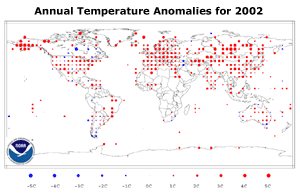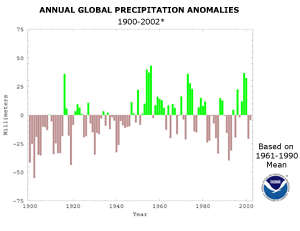



|
 larger image |
Global temperatures were above average during 2002 throughout most land areas. The adjacent figure
depicts the warmer than average temperatures (for a 1961-1990 base period) that were widespread across much of the United States as well as most of Europe and Asia. Temperatures in these regions were 1-4°C (1.8-7.2°F) above the 1961-1990 average. This map was created using data from the Global Historical Climatology Network, a network of more
than 7,000 land surface observing stations.The only widespread areas of negative anomalies were across parts of eastern Canada as well as southern Argentina where temperatures were between 1 and 3°C (1.8-5.4°F) cooler than average.
|
| Notable temperature extremes during 2002 included a severe heatwave during May and June across southwest Asia. Daily maximum temperatures reached as high as 50°C (122°F) which resulted in over 1,000 deaths across India and Pakistan. A series of winter storms affected parts of Bolivia, Peru and Argentina during July and August, bringing heavy snowfall and cold temperatures that were responsible for nearly 60 deaths. Winter storms that affected southeastern Europe during January were accompanied by cold temperatures and local snow depths of over 1 meter (3.3 feet) in parts of Albania, Bulgaria and Greece. |
 Global Precipitation
Global Precipitation larger image |
Global precipitation was below the 1961-1990 average in 2002. Much of Australia experienced severe drought, with the eastern part of the country the worst affected. India monsoon rainfall was 19 percent below normal, with the resulting drought characterized as the worst since 1987. Other drought-affected areas included the western United States and portions of the north coast of China. |
| After a dry beginning to 2002, several typhoons brought excessive rains to parts of southeast Asia and Japan, the southeast coast of China, Taiwan and the Philippines. In contrast to drought conditions during the first half of 2002, the onset of monsoon rains in southeast Asia promoted extensive flooding along the Mekong Delta. Seasonal flooding in much of south Asia (Nepal, Bangladesh and northeastern India) during June-August claimed more than 1,000 lives. In the eastern United States, long-term drought was ameliorated by a turn to wetter weather, due in part to moisture from tropical systems. |
Additional information on other notable weather events can be found in the Significant Events section of this report, or through the monthly Climate Perspectives reports.
 References
ReferencesIPCC, 2001: Climate Change 2001: The Scientific Basis, Contribution of Working Group I to the Third Assessment Report of the Intergovernmental Panel of Climate Change. J.T. Houghton, Y. Ding, D.J. Griggs, M. Noguer, P.J. vander Linden, X.Dai, K. Maskell, and C.A. Johnson (Eds.), Cambridge University Press, 881 pp.

NOAA's National Climatic Data Center is the world's largest active archive of weather data. The preliminary temperature and precipitation rankings are available from the center by calling: 828-271-4800.
NOAA works closely with the academic and science communities on climate-related research projects to increase the understanding of El Niño and improve forecasting techniques. NOAA's Climate Prediction Center monitors, analyzes and predicts climate events ranging from weeks to seasons for the nation. NOAA also operates the network of data buoys and satellites that provide vital information about the ocean waters, and initiates research projects to improve future climate forecasts.

For further information, contact:
Jay Lawrimore-or-
NOAA/National Climatic Data Center
151 Patton Avenue
Asheville, NC 28801-5001
fax: 828-271-4328
email: Jay.Lawrimore@noaa.gov
Scott Stephens
NOAA/National Climatic Data Center
151 Patton Avenue
Asheville, NC 28801-5001
fax: 828-271-4328
email: Scott Stephens@noaa.gov